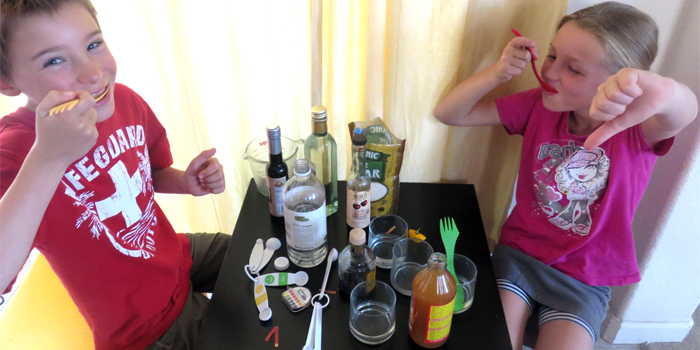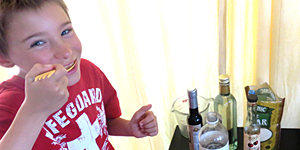Sweet and Sour Tasty Kitchen Science
Family STEM experiment invites sweet and sour taste test fun. What balance of vinegar and sweetener will taste best to your kitchen scientists?

Kitchen Mixing
Some foods are specifically created to be sour, or even very, very, tongue-wrinkling sour, and others are designed to appeal to our sense of sweet. Many tasty foods even combine ingredients with qualities of sour, sweet, salty, bitter, and savory. Cooks and other food scientists work hard to create amazing and mouthwatering foods and drinks they hope will appeal to your sense of taste. They may experiment with different ingredients, or different amounts of each ingredient, or even different ratios of ingredients as they try and make the tastiest food or drink. Once they have a recipe they like, they have a formula which can be used to make the food or drink again. Will it taste exactly the same the next time? If they follow the recipe, they should use the same amount of each ingredient, and the food or drink will hopefully taste the same. How they measure, however, can make a difference!
In this week's family-friendly kitchen chemistry activity, students experiment with creating a drink made from water, a sweetener, and vinegar. In a step-by-step process, students mix and taste test their drinks with varying amounts of sour and sweet. What ratio of each ingredient will have the most pleasing taste? Kids will have fun thinking like chefs and like scientists to create a tasty drink formula. This science activity will also encourage them to think about recipes and how to make sure every batch of a recipe turns out the same.
This sweet and sour exploration begins with vinegar, so get ready for some tongue-wrinkling kitchen science fun!
The following Science Buddies activity on the Scientific American website has all the information you need to do this science activity with your students at home: How Sour or How Sweet Is Your Lemonade?.
Making Connections
To explore other taste-related science projects with your family, see the following hands-on projects and ideas:- Battle of the Senses: Taste Versus Smell
- Bubbly Soda Science
- Do You Have the Willpower to Taste Something Sour?
- Do You Love the Taste of Food? Find Out if You Are a Supertaster!
- Old Salty: Does Age Affect the Ability to Detect Salt?
- Pucker Up: Sweet and Sour Science
- Taste Bud Science
- Taste Test: Do You have the Papillae of a Supertaster?
- Sweet Like Sugar?
- The Science of Too Sour
- Sensory Science: Testing Taste Thresholds
- Shimmy, Shimmy Soda Pop: Develop Your Own Soda Pop Recipe
- Sweet as Sugar: Comparing the Sweetness of Sugar & Sugar Substitutes
Make It Your Own
This week's family science activity uses sugar as an ingredient, but you and your students could use any sweetener to experiment. You could even turn this activity into a comparison of different sweeteners to see how each tastes and which one your taste testers prefer. How do powdered sugar substitutes or sweeteners compare when mixed in the drink? How does a liquid sweetener compare?
Whether your students are interested in sugar alternatives for general health reasons or have an interest in reduced sugar or sugar-free alternatives for Type 1 diabetes or low-carb lifestyles, customizing this family science project is easy to do and can lead to a lot of useful and tasty kitchen fun! What your kids learn about various sweeteners can easily be used to make tasty soda alternatives, sugar-free lemonade, or other beverages. (See the activities and projects list above for additional family science activities that can help guide explorations like these.)
Diabetes and Student Science Projects
For students with a personal interest in science topics related to diabetes, there are many ways to re-focus and customize student science projects to explore aspects of diabetes health, treatment, and technology. See our Diabetes Science Project Ideas page for ideas to get you started. See also: Increasing Awareness about Diabetes with Student STEM Projects.
Categories:
You Might Also Enjoy These Related Posts:
- Star Wars Projects for May the 4th Be With You Science
- Spring Science Projects: 26 Science Experiments for Spring
- 5 STEM Activities with Marshmallow Peeps
- 6 Picks for St. Patrick's Day STEM
- 12 STEM Activities for Lunar New Year - Year of the Dragon Science
- Winter Science Projects, Lessons, and STEM Activities
- Make Some New Year's Noise with Science Projects!
- Holiday STEM Projects to Make and Give










